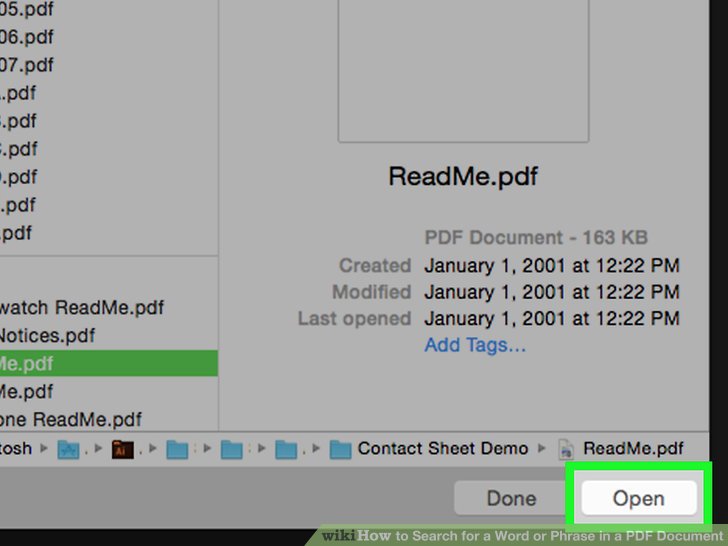Press Command+F to bring up the in-page search box. Alternatively, you can go to the Edit menu Find Find to bring up the search box. Type in your search word or phrase and hit Enter. 1 – Press the Ctrl+F key combination. You'll see a small search box pop up near the top of the screen. 2 – Type the word or phrase you wish to find in the search box. As you're typing, the first occurrence of that word or phrase will automatically be highlighted on the screen.

Did you ever find yourself wanting to correct or replace a word, or phrase, that you've used more than once in a Word document? You go searching through the pages, hoping that your eyes caught them all. You're pretty sure you have and you may still be left with some doubts.
Well, there is an easy cure for that anxiety. It's simply to use the 'Find' or Search feature within your computer. First, open your document and click on the Edit link in the tool bar. Or you can use the keyboard shortcut, the Control Key plus the letter 'f'on a PC or the Command Key, plus the letter 'f' on a Mac.

To make replacement changes, when you find the word remember to highlight it. Then use Control or Command 'x' to delete it. Next edit what's there or type in your new word.
How To Search For Specific Words On Mac Page

Finally, when you are satisfied that you have the word or phrase you wish, highlight and 'Copy' that (Control or Command 'c') Then Paste it over the one you wish to replace.
Find in a Word Document on PC
When you click on Control f to search for words or phrases in a document a pop-up window opens up.
Note: If the document above looks slightly different from yours, I use Open Office, a Free program, on my PC. It has the same features as Word and is compatible with it.
On Your MacIntosh Computer
Find in a Document on a Mac
Command f, i.e. Find, in a Word Document on a Mac brings up a pop-up window for you to type in your desired search word(s).
The Spotlight search field is always available from your iMac's Finder menu bar. Click the magnifying glass icon once (or press the Command key+Spacebar), and the Spotlight search box appears (see the following figure).
To run a search, simply click in the Spotlight box and begin typing. (The words you type that you want to match are keywords.) Matching items start appearing as soon as you type, and the search results are continually refined while you type the rest of your search keywords. In other words, you don't need to press Return to begin your search.
The results of your Spotlight search appear in the Spotlight menu, which is updated automatically in real time while you continue to type. The top 20 most-relevant items are grouped into categories — such as Messages, Definitions, Documents, Folders, Images, PDFs, and Contacts, right on the Spotlight menu. Spotlight takes a guess at the item that's most likely the match you're looking for (based on your Search Results list in System Preferences, which I cover later in the chapter) and presents it in the special Top Hit category that always appears first.
How To Word Search On Windows
Hover your cursor over an item in the Spotlight menu, and shazam! — Spotlight uses the Quick Look technology built into Mavericks to display either a thumbnail image of a document or information on the item. If the item is a song, you can even move your cursor on top of the thumbnail in the Quick Look display and click to play it — all without leaving the Spotlight menu.
How To Search For Specific Words On Mac Pdf
To open the Top Hit item like a true Mavericks power user, just press Return. (My brothers and sisters, it just doesn't get any easier than that.)

Did you ever find yourself wanting to correct or replace a word, or phrase, that you've used more than once in a Word document? You go searching through the pages, hoping that your eyes caught them all. You're pretty sure you have and you may still be left with some doubts.
Well, there is an easy cure for that anxiety. It's simply to use the 'Find' or Search feature within your computer. First, open your document and click on the Edit link in the tool bar. Or you can use the keyboard shortcut, the Control Key plus the letter 'f'on a PC or the Command Key, plus the letter 'f' on a Mac.
To make replacement changes, when you find the word remember to highlight it. Then use Control or Command 'x' to delete it. Next edit what's there or type in your new word.
How To Search For Specific Words On Mac Page
Finally, when you are satisfied that you have the word or phrase you wish, highlight and 'Copy' that (Control or Command 'c') Then Paste it over the one you wish to replace.
Find in a Word Document on PC
When you click on Control f to search for words or phrases in a document a pop-up window opens up.
Note: If the document above looks slightly different from yours, I use Open Office, a Free program, on my PC. It has the same features as Word and is compatible with it.
On Your MacIntosh Computer
Find in a Document on a Mac
Command f, i.e. Find, in a Word Document on a Mac brings up a pop-up window for you to type in your desired search word(s).
The Spotlight search field is always available from your iMac's Finder menu bar. Click the magnifying glass icon once (or press the Command key+Spacebar), and the Spotlight search box appears (see the following figure).
To run a search, simply click in the Spotlight box and begin typing. (The words you type that you want to match are keywords.) Matching items start appearing as soon as you type, and the search results are continually refined while you type the rest of your search keywords. In other words, you don't need to press Return to begin your search.
The results of your Spotlight search appear in the Spotlight menu, which is updated automatically in real time while you continue to type. The top 20 most-relevant items are grouped into categories — such as Messages, Definitions, Documents, Folders, Images, PDFs, and Contacts, right on the Spotlight menu. Spotlight takes a guess at the item that's most likely the match you're looking for (based on your Search Results list in System Preferences, which I cover later in the chapter) and presents it in the special Top Hit category that always appears first.
How To Word Search On Windows
Hover your cursor over an item in the Spotlight menu, and shazam! — Spotlight uses the Quick Look technology built into Mavericks to display either a thumbnail image of a document or information on the item. If the item is a song, you can even move your cursor on top of the thumbnail in the Quick Look display and click to play it — all without leaving the Spotlight menu.
How To Search For Specific Words On Mac Pdf
To open the Top Hit item like a true Mavericks power user, just press Return. (My brothers and sisters, it just doesn't get any easier than that.)
Literally any text string is acceptable as a Spotlight search. However, here's a short list of the common search criteria I use every day:
How To Search For Specific Words On Mac Shortcut
Names and addresses: Because Spotlight has access to the Contacts application in Mavericks, you can immediately display contact information using any portion of a name or an address.
E-mail message text: Need to open a specific e-mail message you've already received, but you'd rather not launch Mail and spend time digging through the message list? Enter the person's e-mail address or any text string contained in the message you're looking for.
File and folder names: A simple item name is the classic search favorite. Spotlight searches your entire system for that one file or folder in the blink of an eye.
Events and Reminder items: Yep, Spotlight gives you access to your Calendar events and those all-important Reminders you've created.
System Preferences: Now things start to get really interesting! Try typing the word background in the Spotlight field. Some of the results will be System Preference panes! Every setting in System Preferences is referenced in Spotlight. (For example, the Desktop background setting resides in the Desktop & Screen Saver pane in System Preferences.)
Web pages: Whoa. Stand back, Google. You can use Spotlight to search the web pages you've recently displayed in Safari! (Note, however, that this feature doesn't let you search through all the Internet like Google does. Instead, you can search only the pages stored in your Safari web cache and any HTML files you've saved to your iMac's hard drive.)
Metadata: This category is a pretty broad, but it fits. If you're not familiar with the term metadata, think of the information stored by your digital camera each time you take a photo: exposure setting, time and date, and even the location where the photo was taken, which are also transferred to iPhoto when you import. Here's another example: you can locate Word documents on your system using the same metadata that's stored in the file, such as the contents of the Comments field in a Word document. Other supported applications include Adobe Photoshop images, Microsoft Excel spreadsheets, Keynote presentations, iTunes media, and other third-party applications that offer a Spotlight plug-in that you've installed.
To reset the Spotlight search and try another text string, click the X icon that appears at the right side of the Spotlight box. Of course, you can also backspace to the beginning of the field, but that's a little less elegant, so try pressing the Command key+A to select the entire contents and then press Delete.
After you find the item you're looking for, you can click it once to
How To Search For Specific Words On Macbook
Launch it (if the item is an application).
Open it in System Preferences (if it's a setting or description on a Preferences pane).
Open it within the associated application (if the item is a document or a data item).
Display it in a Finder window (if the item is a folder).
How To Search For Specific Words On Mac Website
Here's another favorite timesaver: You can display all the files of a particular type on your system by using the file type as the keyword. For example, to provide a list of all images on your system, just use images as your keyword — the same goes for movies and audio, too.
